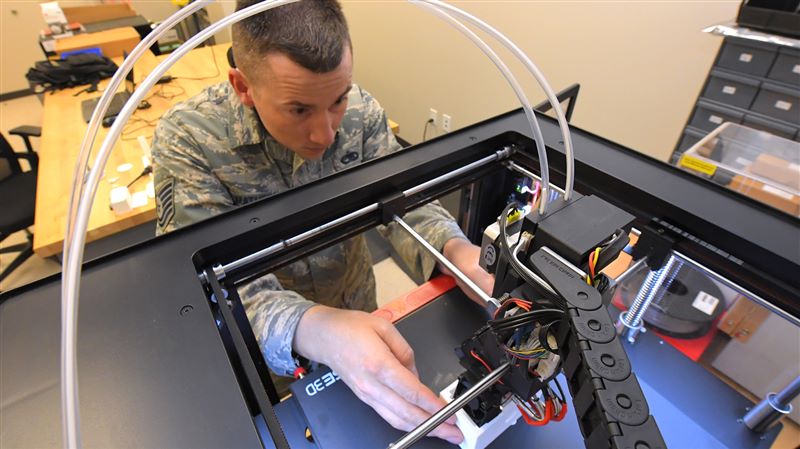In an article by Mitch Shaw of the Standard-Examiner, the role of 3-D printing in support of F-35s at Hill Air Force Base was highlighted.
HILL AIR FORCE BASE — The F-35 is known as a “next generation” fighter jet, so it only makes sense its parts be made through an innovative, modern approach.
Hill Air Force Base‘s 388th Maintenance Group has recently started manufacturing certain F-35 replacement parts with a 3D printer. Base officials hope the new method will increase availability and drive down costs for the components.
“We’re always driving for speed, safety and quality,” said 388th MG commander Col. Michael Miles. “But cost-effectiveness is also a priority. This new tech has great cost-avoidance potential and provides rapid repair capabilities.”
Operating off of an electronic data source, 3D printers are controlled by a computer and put down layers of material like gypsum and plastic to create objects of nearly any shape. The technology has an almost endless spectrum of application.
Tech. Sgt. Scott Mathews, assistant manager of the 388th MG’s Air Force Repair and Enhancement Program, said when his shop receives damaged parts that can be reproduced by the 3D printer, early returns are indeed showing maintainers can get them back to the supply chain faster and for less money.
“It’s much more cost effective for the Air Force than buying new parts,” he said.
So far, the team has been reproducing simple plastic parts like wiring harnesses, grommets, fasteners, housing boxes and cable splitters. The process is still in its infancy and the airmen in the unit have been refining the operation through trial and error — making their own in-house designs generated with computer software.
Mathews said in many areas, his shop is “getting away from a lot of fancy metals and getting into composites and plastics” — a reality that’s made 3D printing more workable.
But there’s been positive signs that even more complex parts, requiring sturdier material, could one day be manufactured in-house.
“There’s one printer (where) you can print with aluminum,” Mathews said. “That opens up a whole new world of opportunities. When you look at all of the different parts we could manufacture … it just boggles the mind, the things we could (make) on base. It’s just insane.”
Hill received its first two F-35s in September 2015. By the end of 2019, the base will house three fighter squadrons made up of 78 jets. The active duty 388th Fighter Wing and the reserve 419th fly and maintain the jets.
The base’s Ogden Air Logistics Complex performs maintenance on all of the U.S. Air Force F-35s.
One advantage of the F-35 global enterprise is that learning from one partner or in the case of the US, one service, can provide inputs to others in the global enterprise.
Given who is flying the F-35, this means that very advanced airpower are enhancing their capabilities through a built-in process of cross learning.
This is very significant indeed.
With regard to the US Navy, Edward Timperlake suggested that cross learning from the USAF to the sea services could provide a significant opportunity to leverage the sea base where parts could be manufactured afloat, which would provide a significant step forward with regard to aircraft availability.
The weight and cube of prepackaged parts and supply consumables for Ships at sea is always of concern for all Carriers and surface combatants at sea.
I hope the sea services learns fast from AF innovation and F-35 B/C is a perfect “ proof of concept” opportunity with regard to cross learning.
Imagine the USN supply ships just cross decking essentially raw material.
The sea base is being redefined with a redrafting of the amphibious task force and associated working relationships with other air, surface and subsurface assets.
What 3D Printing once further advances are made can do is allow various elements of a sea based force to better sustain combat capabilities afloat without having to have organic original replacement parts aboard, or to be able to supplement short supplies on demand.
This means that for an airborne force at sea that the readiness rates can go up along with seabased availability
When we visited the USS America, one of the key takeaways was how the ship was built to facilitate air operations and maintenance for the air systems.
The ship has three decks and certainly the bottom deck has a number of work areas where 3D printing could easily be done and to support maritime air forces.

As the ship will be a regular operational center for Ospreys, for example, Osprey parts might be manufactured for the US Navy with its Ospreys operating now in the supply role.
What this means as well is that 3D Printing supporting USMC F-35Bs could be available to support other F-35Bs users in the area of operation where the Marines are operating, or in turn, to work with ashore facilities.
It is yet another area where, for example, the Queen Elizabeth and the USS America could work together to sustain airpower afloat.
The featured photo shows Tech Sgt. Scott Mathews, assistant manager of the 388th Maintenance Group’s Air Force Repair and Enhancement program, makes adjustments to a 3-D printer the unit is experimenting with to create pieces and parts faster and more cost-effectively. Photo by Todd Cromar.
For an overview on the changes and a video which explains them for KSL TV, see the following:


